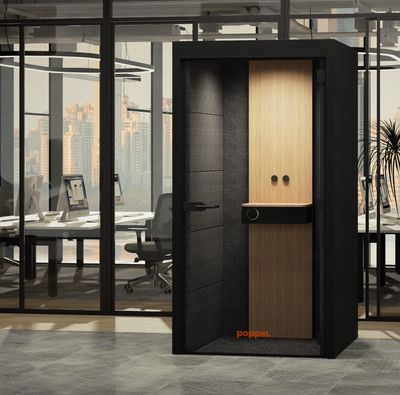
Adapting Offices for Hybrid Work: Insights from an HR Expert
The hybrid workplace is here to stay. How can companies adapt to support a hybrid workforce? Discover expert insights from Tim Sackett, President of HRU Technical Resources and HR expert, as we explore key strategies for companies to adapt and thrive in the era of hybrid work.
How do you envision the future of work in terms of remote and flexible work arrangements?
I envision the future of work being like our grandparents and parents probably always hoped it would be: treat us like adults! You hired me to do a job, tell me what needs to be accomplished and what goals need to be met, give me the tools to do it, and get out of my way. That might mean I don’t come into the office on Wednesday, or it might mean I come in to work every day. I’ll let my high performance dictate where I do my best work based on measurable results.
How can offices be redesigned to support the future of work?
It’s not just the office that needs to be redesigned but how we arm our employees to be productive and functional no matter where they might be. Getting away from designed spaces for those hybrid workers who come and go and developing commuter spaces that easily adapt to someone sitting down in a new space but being able to get up and running in minutes. At the same time, if someone is super productive in a designated permanent space, we also have to have those.
With the potential for increased remote work, how can HR professionals maintain a sense of organizational culture and ensure strong employee connections and collaboration?
The reality is remote work increased a few percentage points over pre-pandemic. It’s now fallen back into a steady state. We’ve definitely seen a giant increase in hybrid work, so your question about culture build and connection remains. We have three distinct work groups: remote, hybrid, and on-premise. Every single workgroup faces the same culture dilemma. We need to be connected to our work, to our organization, and to each other. No one has the secret sauce in solving this as of yet, but ensuring frequent connection is going to be key. It can’t just be Slack, Teams, and Zoom. We have to be more conscious about getting our people together for real connection, even those who are primarily remote. Being remote doesn’t mean never meeting in person with your peers and partners. This will take time and resources, and companies that value culture will budget to make it happen frequently.
What strategies should organizations adopt to promote employee engagement and well-being in a future workplace that may be more virtual and dispersed?
We have to better understand that the epidemic of loneliness is something that organizations can have a major impact on. If the business decides that remote work is the strategy that gives you the best avenue for success, then we have to ensure we are providing opportunities for connection at a very real level for our remote workforce. But the reality is we have employees who are showing up to offices every single day that are desperately lonely. I believe one major competency future HR leaders and teams must have is around ensuring no employee is left without connection. We can use tech to help us ensure no one gets missed, but it’s one of the few things that truly sets us apart as humans is our need for connection to thrive. HR can have a real impact on making sure everyone in the organization feels a connection, and no one feels alone.
What role will technology play in shaping the future of work, and what impact will it have on HR practices?
AI is going to transform the future of work in every function. For the most part, any kind of high-volume, easy-to-perform tasks will be done or assisted in being done by AI, which increases the productivity of workers. The key for HR professionals will be helping our workforce understand how to use the power of this new productivity to add even more value to their role and the organization. This won’t happen overnight. Like most technology, it happens little by little until one day, you wake up and realize it’s transformed how we live and do work. AI will be no different.
How can HR professionals leverage artificial intelligence and automation to streamline HR processes and enhance productivity?
AI will touch every single aspect of what we do in HR. From simple tasks like collecting weekly time cards from hourly employees to answering complex questions in HR self-service for our employees. HR will first come into contact with AI as a feature of the broader HCM technology. We’ll see it and use it like a co-pilot in our daily work and activities. It will be that true virtual assistant helping us in our day-to-day. Over time, it will become invisible, doing things behind the scenes and making us more productive. Like a real-time business coach that never leaves us.
In light of increased automation, how can HR contribute to reskilling and upskilling initiatives to ensure employees remain relevant and competitive in the job market?
Part of the future of HR is that the function must own skills. To know who has what and also which skills the organization needs to increase and add, then go find out who are the best candidates to go down those paths. We are so used to buying skills we need it’s going to be a challenge getting back to a mentality of building skills for the long term.
How do you anticipate the evolution of employee skills and competencies in response to the changing nature of work?
The only real change in skills and competencies I anticipate we’ll see is around speed and connection. Everyone should have the ability to learn new skills much quicker than the previous generation. The availability to acquire new skills is unprecedented in history as it is today. Plus, technology will make it easier for us to understand what skills we need to add or increase as work changes.
How should HR professionals adapt their talent acquisition and retention strategies to attract and retain top talent in this rapidly changing work landscape?
It’s never been easier in the history of the world to find talent. Yes, you read that correctly. It’s never been harder to talk a candidate into your average pay, average benefits, average job, average location, and average leadership. You have to stand out in some area. Maybe you’re the highest payor in your market. Maybe you have the greatest leaders. Maybe you have some benefits no one else offers. Great talent acquisition isn’t about attracting everyone; it’s about attracting the few specific candidates who are the right fit for your organization. Stop trying to be everything to everyone and pick up the phone and make people feel wanted and desired.













